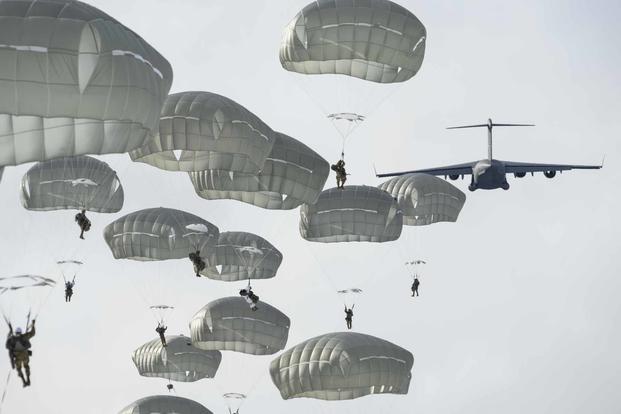The 11th Airborne Division, the Army's newest major unit, will be formed June 6 out of an assortment of soldiers in Alaska.
"It's long overdue; this is a compilation of years of effort to get us to a functional organization," Maj. Gen. Brian Eifler, commander of U.S. Army Alaska, told Military.com.
But that new designation will not add any additional airborne capabilities to the Arctic region, which U.S. adversaries are already trying to lay claim to.
Read Next: Deal for Sweeping Toxic Exposure Bill Reached in Senate
Currently, there are two major Army formations in Alaska: the 1st Stryker Brigade Combat Team, 25th Infantry Division, and the 4th Infantry Brigade Combat Team (Airborne), 25th Infantry Division. Those will be redesignated the 1-11 Airborne and 2-11 Airborne, respectively. U.S. Army Alaska will also be absorbed into the new division.
Army officials are in the middle of finalizing a plan to get rid of its roughly 320 Strykers in Alaska, possibly using them for spare parts for other units. In the meantime, the Stryker brigade in Alaska will convert to a regular light infantry force, but could be converted into an air assault element down the road.
"This isn't going to be like any other division. Here, we are having an airborne brigade, and there will probably be an air assault brigade," said Eifler, who will command the 11th Airborne Division. "It'll be different."
Eifler noted that plans for how the division will be organized aren't ironed out yet. Getting half of the division's soldiers air assault-qualified and setting up logistics for the training those soldiers could take years.
The new division will also see the creation of a sustainment headquarters and an aviation task force headquarters. But the overall current size of the Army's presence in Alaska is expected to remain roughly the same, at around 12,000 soldiers, because a light infantry brigade is smaller than a Stryker brigade.
The plan for forming Alaska's two major brigades under a new patch is largely about giving U.S. Army Alaska a clear identity, Eifler said. Currently, the two brigades wear the 25th Infantry Divison's patch, which is associated with that division's focus on jungle warfare, the opposite of Alaska's Arctic mission.
"Soldiers in Alaska haven't had an identity. It has been a bunch of units with different patches," Eifler said. "Now, we'll have a unified legacy we can continue on."
Being a division, EIfler hopes, will open up easier access to resources from the Pentagon, with the soldiers getting more attention from planners. The Army's so-called Arctic strategy put those units in the spotlight, with the force's refocus on conventional warfare and the need for a unit dedicated to fighting in the frigid environments where Russia and China are trying to claim dominance.
Alaskan troops will have some of the busiest schedules in the Army over the next year, working with allied nations who are developing their own Arctic doctrines.
In March, Alaska troops, as well as U.S. special operations and some foreign units, conducted a first-of-its-kind, large-scale training event putting its troops and gear to the test. Right now, many of Alaska's soldiers are training in Norway. There is also a planned exercise in Japan known as North Wind later this year. And, in early 2023, soldiers will repeat the major training exercise in Alaska.
"We have Nepal, Mongolia, India, northern Japan, [South] Korea -- we have these countries that have mountainous and extreme cold weather terrain and we're going to start working with them more,'' Eifler said.
-- Steve Beynon can be reached at Steve.Beynon@military.com. Follow him on Twitter @StevenBeynon.












